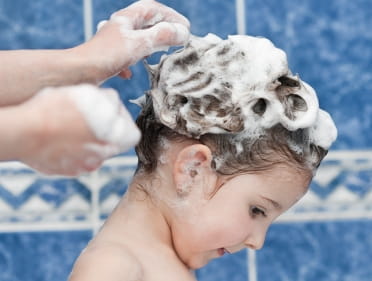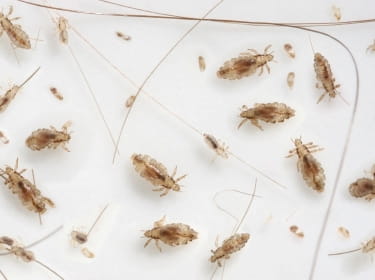Take Care with Head Lice Treatments

The Bottom Line
Head lice can affect just about any one. They are not dangerous but they cause miserable itching. Treating head lice involves combing the lice and their eggs (nits) from each strand of hair. Often a chemical also must be used to prevent additional lice from hatching. Follow instructions carefully. Keep products out of eyes, because they can be irritating.

The Full Story
Head lice have tormented humans for thousands of years. These little bugs live on the scalp and feed on blood. Their eggs, called "nits", attach to hair. The most common victims are children from about three to twelve years old. They affect all income and social classes.
Lice don't cause illness, but they do cause itching - a lot of itching. Scratching that itch can break the skin and cause an infection.
Lice on the scalp can jump from one head to another close-by head. Then, the cycle of infestation, egg-laying, and itching starts on someone else. That's why children are sent home from school if they have active lice infestations. Otherwise, the lice can move from child to child.
Diagnosis of lice is not complicated. Often the tiny lice can be seen on the scalp. That is enough to diagnose an active lice infestation. These lice must be removed and/or treated in some way. Otherwise, they will continue to cause itching. And, they will continue to lay eggs.
Lice jump around. But their eggs, or nits, attach firmly to strands of hair. The hard nits have tiny pores. These allow air to enter until the new lice hatch in several days. A nit attached to the hair at scalp level is likely alive. It must be treated and/or removed so it doesn't hatch. Once the nit has grown away from the scalp, the louse probably has already hatched. In that case, no treatment may be needed.
Treatment of head lice involves removing lice and nits, then treating with some type of lice medicine. (Lice medicines are called "pediculicides", because the Latin name for head lice is Pediculosis humanus var. capitis.)
Combing the hair with a very fine-toothed comb removes some lice and also removes nits from the hair strands. This is an important but tedious process, because every hair needs to be combed. Occasionally, this is enough to stop an infestation.
Most often, treatment with a chemical pediculicide also is needed. The first treatment is used to kill active lice. The treatment must be repeated if all the lice don't die with the first treatment. Additional treatment may be needed in about seven to nine days to kill lice that hatch from remaining nits.
Choosing a pediculicide is tricky. From time to time, lice develop resistance to particular chemicals. A treatment that works for a while may become ineffective over time as the lice adapt. If your child has lice, consult your pediatrician or the school nurse about the best treatments. If one type of treatment doesn't work, ask about the next treatment to try. Using the same treatment again might not work.
Here are some of the common treatments. Note that any of them might cause skin irritation. If they get into the eyes, they can irritate the eyes, too.
- Pyrethrins with piperonyl butoxide. This combination of substances can be bought without a prescription. Pyrethrin is a pesticide based on chrysanthemums. Piperonyl butoxide is added to help the pyrethrin work for a longer time. This treatment kills live lice but not nits. The product must be applied more than once, first to kill the existing lice and then to kill newly-hatched lice. There are several brands, including A-200®, Clear®, Pronto®, and RID®.
- Permethrin. This is like pyrethrin, but is synthetic. Permethrin is approved for use on infants older than two months and in pregnant women. Products with 1 percent permethrin are available without a prescription; one brand name is Nix®. A stronger product is available by prescription; it is approved to treat scabies but some physicians prescribe it for lice.
- Malathion. This pesticide kills live lice and some of their eggs. It is a prescription medicine that can be used on children aged six and over. A brand name is Ovide®.
- Benzyl alcohol. This lotion suffocates lice but not their eggs. It is available by prescription and can be used on children as young as six months. The brand name is Ulesfia®.
- Spinosad is a bacterial ingredient found in a lotion called Natroba®. This is different from other lice medicines in that combing is not required.
Many people try home remedies. They may want to avoid chemicals or available treatments haven't worked. Unfortunately, home remedies don't work well, either. Vinegar, isopropyl alcohol, olive oil, mayonnaise, melted butter, and petroleum jelly have been studied and found ineffective. An Australian study found that tea tree oil and lavender oil were quite effective, but these products are not on the approved and recommended list published by the Centers for Disease Control.
There are conflicting recommendations about how much effort to put into laundering, vacuuming, etc. when a child brings home a case of head lice. In general, clothing, hats, and linens worn within the previous few days should be laundered in hot water. Upholstered furniture and rugs can be vacuumed. Since lice and their eggs can't live for long without a human host, any that fall off will die within a day or two.
Consult your pediatrician, school nurse, or pharmacist about which lice medicine to use. Use the webPOISONCONTROL® online tool for guidance or call Poison Control if a child swallows lice shampoo or medicine. Also use the online tool or call 1-800-222-1222 if someone splashes these products into the eyes.
Rose Ann Gould Soloway, RN, BSN, MSEd, DABAT emerita
Clinical Toxicologist
Poisoned?
Call 1-800-222-1222 or
Prevention Tips
- Choose the correct treatment. It can be different from time to time and from place to place. Contact your school nurse or pediatrician for advice.
- Comb out nits and lice carefully. It's a tedious but necessary job.
- If you need to use a chemical treatment, follow the instructions carefully. This is important for two reasons: safety and effectiveness.
This Really Happened
Case 1: A fourteen-year-old girl was prescribed lindane shampoo for head lice. She was supposed to use it every seven days. However, the day after she first used the lindane, she noticed a couple of lice in her hair and shampooed with it again. The child vomited all night following the second shampoo use and developed a severe headache. Her mom called Poison Control several hours after the child last applied the lindane. At that time, it was believed that she was no longer at risk for seizures. Home observation was therefore recommended. Her headache lingered, despite over-the-counter pain relievers, for a few days.
Case 2: The mom of a school-age child caught head lice from her son after he had been at camp. She used a lice killing shampoo containing a pyrethrin. Some of the shampoo got in her mouth and she had some tingling of her tongue. Poison Control reassured her that this effect would be expected; the small amount of pyrethrin would not poison her. She rinsed her mouth well and was then fine.
For More Information
Podcast and written information - "Head Lice: What Parents Need to Know (AAP)References
Poisoned?
Call 1-800-222-1222 or
Prevention Tips
- Choose the correct treatment. It can be different from time to time and from place to place. Contact your school nurse or pediatrician for advice.
- Comb out nits and lice carefully. It's a tedious but necessary job.
- If you need to use a chemical treatment, follow the instructions carefully. This is important for two reasons: safety and effectiveness.
This Really Happened
Case 1: A fourteen-year-old girl was prescribed lindane shampoo for head lice. She was supposed to use it every seven days. However, the day after she first used the lindane, she noticed a couple of lice in her hair and shampooed with it again. The child vomited all night following the second shampoo use and developed a severe headache. Her mom called Poison Control several hours after the child last applied the lindane. At that time, it was believed that she was no longer at risk for seizures. Home observation was therefore recommended. Her headache lingered, despite over-the-counter pain relievers, for a few days.
Case 2: The mom of a school-age child caught head lice from her son after he had been at camp. She used a lice killing shampoo containing a pyrethrin. Some of the shampoo got in her mouth and she had some tingling of her tongue. Poison Control reassured her that this effect would be expected; the small amount of pyrethrin would not poison her. She rinsed her mouth well and was then fine.
